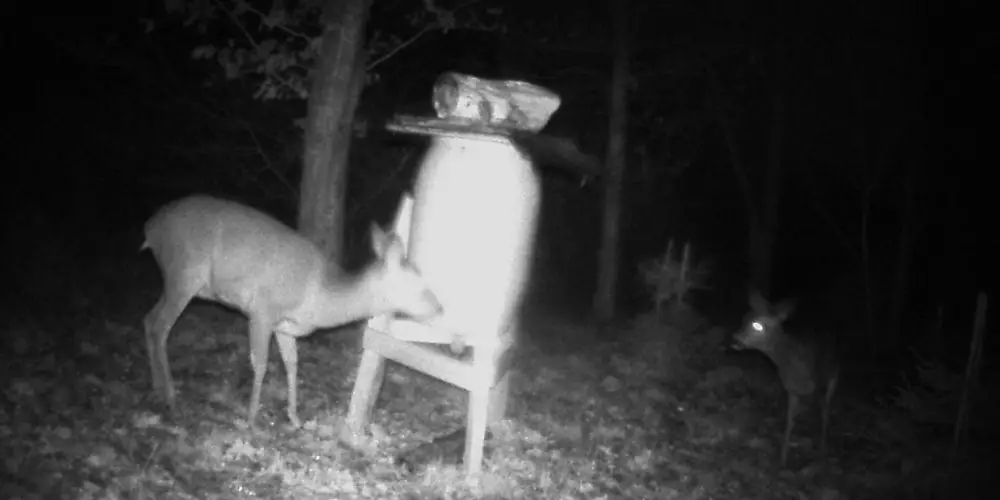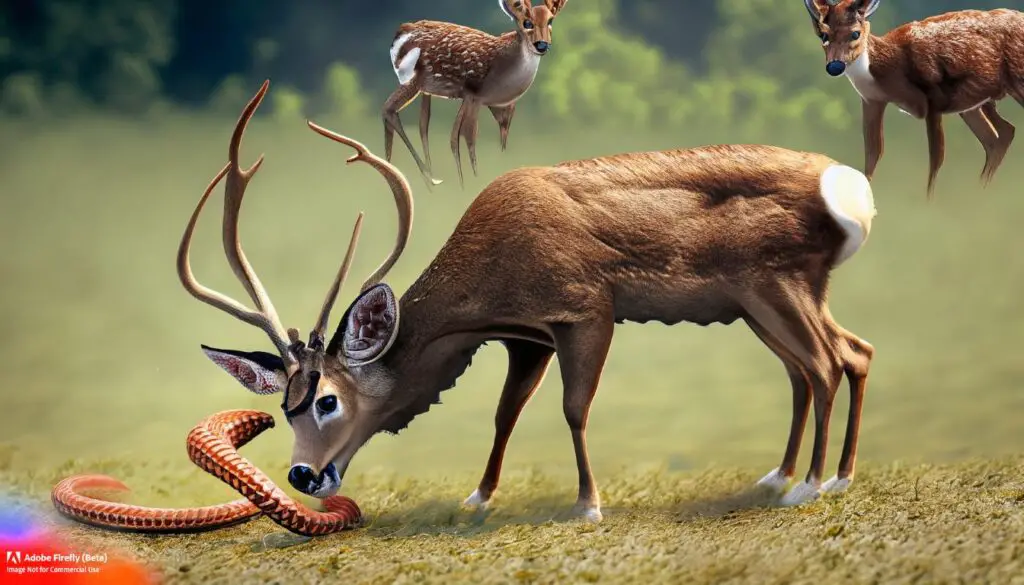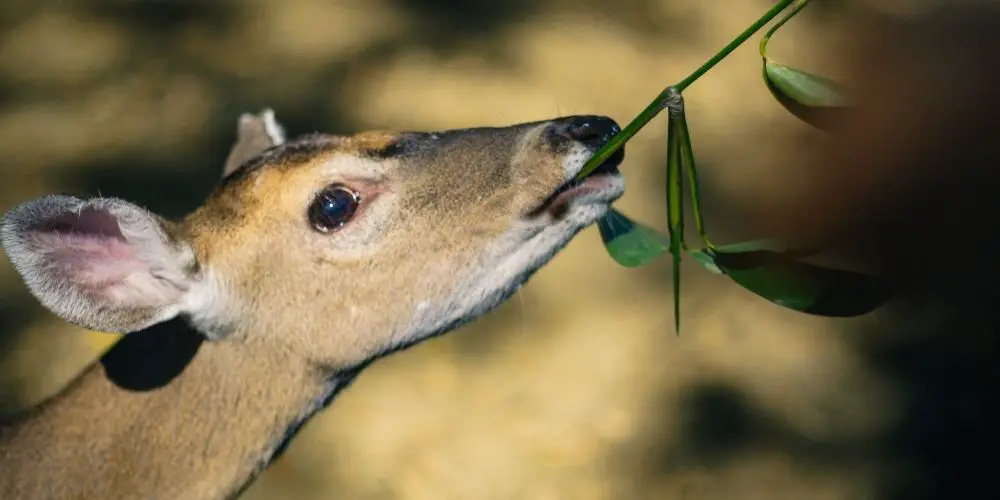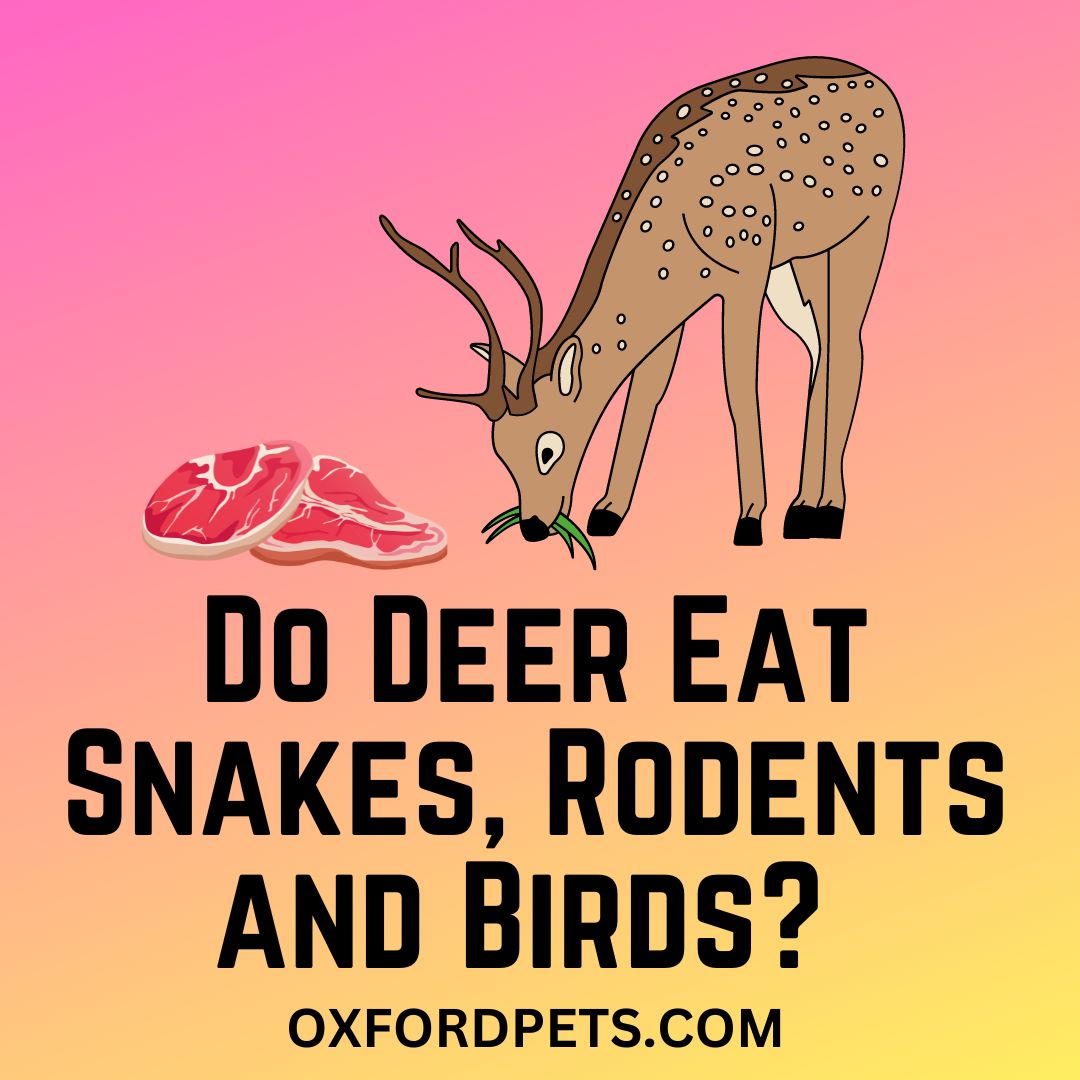Deer are mostly herbivores, but they can exhibit opportunistic behavior and scavenge carcasses for meat. So, to answer the question “Do deer eat meat?” – the answer is yes, sometimes. In such cases, deer can consume edible meat from carcasses they come across. Moreover, deer may also eat baby chicks, Tiny birds, Bird eggs, dead squirrels, Mice, rabbits, small mammals and even insects mainly due to their thin skin that can be easily broken through and ground. However, it’s important to note that these instances are not common, and the majority of a deer’s diet consists of plant material.
As per some wildlife experts, there have been sightings of deer at ritual sites where humans or other animals are buried. It is believed that the deer may be attracted to the scent or out of curiosity. In some cases, they have been seen chewing on human bones, but it is unclear whether they consume human flesh or only the bones.
Contents
- 4 Reasons why deer consumes snakes or meat occasionally:
- 10 Animals That Deer Devour And Why
- Live Video Proof of Deer Chomping a Dead Snake
- Do deer eat Reptiles, Birds and Rodents?
- Do Deer Eat Birds or Eggs?
- Do Deer Eat Mice, Squirrel, Rabbits and Rodents?
- Would a Captive deer eat meat?
- How Much Do Deer Eat?
- What do deer eats being herbivores?
- Where Do Deer Eat In The Wild?
- Summary
4 Reasons why deer consumes snakes or meat occasionally:
- Scavenging: Deer may scavenge on carcasses of dead animals, including snakes or meat, if they come across them in their habitat. In such cases, deer are drawn to the available nutrients and energy sources present in the animal remains.
- Nutritional deficiency: In certain situations, PREGNANT deer may consume meat or snakes as a response to specific nutritional deficiencies. For instance, if a deer’s diet lacks sufficient protein or certain minerals, it might seek alternative sources of nutrients, which could include small amounts of animal matter.
- Accidental ingestion: Sometimes, deer may inadvertently consume snakes or meat while foraging for plants. For example, if a snake is hidden within the vegetation or if a deer accidentally ingests insects or small animals while grazing, it may inadvertently consume meat.
- Curiosity or exploration: Young deer, particularly fawns, are known to be curious and explore their surroundings. They may occasionally nibble on various objects, including snakes or small animal carcasses, out of curiosity or in an attempt to taste different things.
It’s important to note that these instances are not common behavior for deer and are considered exceptions rather than the norm. The mainstay of a deer’s diet consists of plant material, and they have adapted anatomically and physiologically to thrive on a herbivorous diet.
10 Animals That Deer Devour And Why
Deer are primarily herbivores, but in rare instances, they have been known to consume small animals as well. Here are ten animals that deer have been observed eating, along with possible reasons why:
- Rodents: Deer have been observed consuming small rodents such as mice and voles. It is thought that they may do this to supplement their diet with protein during times when their preferred food sources are scarce.
- Birds: As mentioned earlier, deer have been observed consuming bird carcasses, likely scavenging on the remains of a dead bird rather than actively hunting live birds.
- Insects: Deer have been known to consume insects, particularly during the summer months when they are abundant. Insects are a good source of protein and can help supplement the deer’s diet.
- Lizards: Deer have been known to eat lizards, particularly in areas where they are abundant. Lizards are a good source of protein and other nutrients.
- Snails: Deer have been known to eat snails, particularly during the summer months when they are abundant. Snails are a good source of calcium and other minerals.
- Frogs: Deer have been known to eat frogs, particularly in areas where they are abundant. Frogs are a good source of protein and other nutrients.
- Fish: Deer have been known to eat fish, particularly in areas where they are abundant. Fish are a good source of protein and other nutrients.
- Carrion/Dead Animals: Deer have been known to scavenge on the remains of dead animals, particularly during the winter months when food sources are scarce.
- Squirrels: Deer have been observed consuming squirrels, particularly during times of food scarcity. Squirrels are a good source of protein.
- Birds’ Eggs: Deer have been known to consume birds’ eggs, particularly in areas where they are abundant. Eggs are a good source of protein and other nutrients.
It is worth noting that while deer may consume these animals, they are not adapted to be predators and do not actively hunt or seek out prey. These instances of deer consuming small animals are rare and opportunistic.
Live Video Proof of Deer Chomping a Dead Snake
Do deer eat Reptiles, Birds and Rodents?
While deer are primarily herbivores and their diet consists mainly of plant material, they have been known to occasionally consume small animals such as rodents, rabbits, and birds. However, this behavior is not common and is typically only observed in cases of extreme hunger or as an opportunistic behavior.
Overall, the vast majority of a deer’s diet consists of plant material, and they are well adapted to extract nutrients from a wide range of vegetation. While they may occasionally consume small animals such as rodents, rabbits, and birds, it is not a significant part of their natural diet.
As for snakes, while there have been anecdotal reports of deer consuming snakes, it is not a significant part of their diet, and they are not well-suited to hunting or consuming them regularly. In most cases, if a deer consumes a snake, it is likely due to the snake being in close proximity to the deer’s food source or as an opportunistic behavior.
Deer are more likely to avoid snakes as a defense mechanism, as some species of snakes can be venomous and pose a threat to them.
Do Deer Eat Birds or Eggs?
Again, deer don’t hunt or kill like true meat-eaters. However, they have been known to eat live birds. People have caught deer eating baby birds right from their nests.

There are instances of Researchers Field Cameras Catch Deer Eating Birds
While it is not common for deer to eat birds, there have been instances where they have been observed doing so. Field cameras have captured footage of deer consuming bird carcasses, likely scavenging on the remains of a dead bird rather than actively hunting live birds.
It is important to note that deer are primarily herbivores and their diet consists mainly of vegetation. They are not typically known to be predators and are not adapted to actively hunt or consume meat on a regular basis.
It is possible that in rare instances, deer may opportunistically consume small animals such as rodents or birds if their preferred food sources are scarce. However, this is not a common behavior and is not a significant part of their diet.

Do Deer Eat Mice, Squirrel, Rabbits and Rodents?
Yes, deer have been observed consuming small animals such as mice, squirrels, rabbits, and rodents. Deer will devour pretty much anything that doesn’t stand up a fight or resist. However, as I mentioned earlier, these instances of deer consuming small animals are rare and opportunistic.
Deer are primarily herbivores and their diet consists mainly of vegetation. They may consume small animals only when their preferred food sources are scarce or when they come across them accidentally while browsing for vegetation.
Would a Captive deer eat meat?
I can say for fact that deer will eat some weird stuff. I have personally watched captive deer eat a fledging sparrow as well as some immature cottontails, and even eggs.
I’ll admit that captive deer might also have a boredom factor involved, but it is well documented that deer will sometimes take in alternate sources of protein.
Seaweed with all the life thats in it, dead fish and even the tails of their fawns have been noted. The snake is a first for me, though. I can say if that doe was simply defending her young, shed use her hooves to stomp the snake, Ive seen that enough times.
How Much Do Deer Eat?
The amount of food that a deer eats can vary depending on a number of factors, including their age, sex, and the availability of food in their environment. In general, deer consume approximately 3-5% of their body weight in vegetation per day.
For adult deer, this means they may consume anywhere from 4-10 pounds of vegetation per day, depending on their size and nutritional needs. Fawns, or baby deer, consume less food than adults, and may eat only 1-2 pounds of vegetation per day.
The amount of food that a deer eats can vary depending on a variety of factors, such as the season, availability of food, and the deer’s age and size. However, on average, an adult deer can consume around 6 to 8 pounds of vegetation per day.
According to the Mississippi State University Extension Service, a deer’s diet can range from 6 to 10 percent of its body weight per day, depending on the time of year and food availability. During the winter months when food is scarce, deer may eat up to 10 percent of their body weight per day.

What do deer eats being herbivores?
Deer are primarily herbivores, and their diet consists mainly of leaves, twigs, and fruits. Here are some common types of vegetation that deer eat:
- Grasses: Deer eat a variety of grasses, including bluegrass, ryegrass, and fescue. These are a common food source for deer, especially during the summer months when they are readily available.
- Leaves: Deer eat leaves from a variety of trees and shrubs, including maple, oak, and hickory. They will also eat the leaves of fruit trees such as apple and pear trees.
- Twigs and stems: Deer will browse on the twigs and stems of woody plants, such as dogwood, sumac, and blackberry bushes.
- Acorns and nuts: Deer are known to eat acorns, which are a good source of protein and fat. They will also eat nuts from trees such as hickory and beech.
- Fruits: Deer will eat a variety of fruits, including blackberries, raspberries, and strawberries. They will also eat fruits from trees such as persimmon and wild cherry.
Where Do Deer Eat In The Wild?
Deer are found in many different habitats, and their diet can vary depending on their location and the season. In the wild, deer typically eat in areas where there is a diverse array of vegetation, including forests, meadows, and wetlands.
During the spring and summer months, deer will often feed on tender shoots, leaves, and fruits. They may browse on shrubs and trees or graze on grasses and forbs in open meadows. In forested areas, deer may browse on understory plants or eat the leaves and buds of trees.
During the fall and winter months, when the availability of tender vegetation is reduced, deer will rely more heavily on woody browse such as twigs, bark, and buds of trees and shrubs. They may also consume acorns, nuts, and other hard mast from trees, as well as dried grasses and sedges.
Deer are selective feeders and prefer certain plant species over others. They use their sense of smell to detect the quality and palatability of vegetation before consuming it. Deer also need access to water and may drink from streams, ponds, or other sources of freshwater.
Overall, deer are adaptable and can thrive in a variety of habitats, as long as there is a sufficient supply of diverse vegetation for them to eat.
Summary
In conclusion, deer are primarily herbivores and their diet consists mainly of leaves, twigs, and fruits. While they have been known to occasionally consume small animals such as rodents, rabbits, and birds, this is not a significant part of their diet. Deer are adapted to a herbivorous diet, and their digestive system is designed to break down and extract nutrients from tough plant material.
Reference:
Whitaker, Jr., J. O., & Hamilton, W. J., Jr. (1998). Mammals of the Eastern United States. Cornell University Press.
